Spatial-Temporal Dynamics of Urban Green Spaces in Response to Rapid Urbanization and Urban Expansion in Tunis between 2000 and 2020
Abstract
1. Introduction
2. Materials and Methods
2.1. Study Case
2.2. Data Source and Research Framework
2.3. Data Processing
2.3.1. Land-Use Transfer Matrix
2.3.2. Landscape Pattern Index
2.3.3. Moving Window Method
3. Results
3.1. Land-Use Types: 2000–2020
3.2. Analysis of the Spatial Transfer of Building Land and Green Space from 2000 to 2020
3.2.1. Analysis of the Spatial Transfer of Building Land
3.2.2. Analysis of Spatial Shifts in Green Spaces
3.3. Characteristics and Changes in the Landscape Patterns of Built-Up Land and Green Spaces between 2000 and 2020
3.3.1. Landscape Index Characteristics
3.3.2. Changes in Landscape Patterns
4. Discussion
4.1. Characteristics and Trends of the Expansion of Built-Up Areas in Tunis
4.2. Changing Characteristics and Development Trends of Green Spaces in Tunis
4.3. Lack of Rational Urban Planning Strategies Is the Main Reason for the Blind Expansion of Tunis
4.4. Building a Complete Network of Green Space Systems Is an Urgent and Prominent Issue in Tunis
5. Conclusions
Author Contributions
Funding
Data Availability Statement
Acknowledgments
Conflicts of Interest
References
- Antrop, M. Landscape change and the urbanization process in Europe. Landsc. Urban Plan. 2004, 67, 9–26. [Google Scholar] [CrossRef]
- Wolch, J.R.; Byrne, J.; Newell, J.P. Urban green space, public health, and environmental justice: The challenge of making cities ‘just green enough’. Landsc. Urban Plan. 2014, 125, 234–244. [Google Scholar] [CrossRef]
- Audirac, I.; Shermyen, A.H.; Smith, M.T. Ideal Urban Form and Visions of the Good Life Florida’s Growth Management Dilemma. J. Am. Plan. Assoc. 1990, 56, 470–482. [Google Scholar] [CrossRef]
- Batty, M.; Besussi, E.; Chin, N. Traffic, Urban Growth and Suburban Sprawl; Centre for Advanced Spatial Analysis: London, UK, 2003. [Google Scholar]
- Bhatta, B.; Saraswati, S.; Bandyopadhyay, D. Urban sprawl measurement from remote sensing data. Appl. Geogr. 2010, 30, 731–740. [Google Scholar] [CrossRef]
- Colsaet, A.; Laurans, Y.; Levrel, H. What drives land take and urban land expansion? A systematic review. Land Use Policy 2018, 79, 339–349. [Google Scholar] [CrossRef]
- Marshall, J.D. Urban land area and population growth: A new scaling relationship for metropolitan expansion. Urban Stud. 2007, 44, 1889–1904. [Google Scholar] [CrossRef]
- Erlwein, S.; Zölch, T.; Pauleit, S. Regulating the microclimate with urban green in densifiying cities: Joint assessment on two scales. Build. Environ. 2021, 205, 108233. [Google Scholar] [CrossRef]
- Larbi, H.; Leitmann, J. Tunis. Cities 1994, 11, 292–296. [Google Scholar] [CrossRef]
- Malcevschi, S.; Bisogni, L. Green Infrastructures and ecological reconstruction in urban and peri-urban areas. TECHNE-J. Technol. Archit. Environ. 2016, 11, 33–39. [Google Scholar]
- Wang, J.; Yu, C.W.; Cao, S.-J. Planning for sustainable and ecological urban environment: Current trends and future developments. Indoor Built Environ. 2023, 32, 627–631. [Google Scholar] [CrossRef]
- Son, T.H.; Weedon, Z.; Yigitcanlar, T.; Sanchez, T.; Corchado, J.M.; Mehmood, R. Algorithmic urban planning for smart and sustainable development: Systematic review of the literature. Sustain. Cities Soc. 2023, 94, 104562. [Google Scholar] [CrossRef]
- Bounfour, A.; Lambin, E.F. How valuable is remotely sensed information? The case of tropical deforestation modelling. Space Policy 1999, 15, 149–158. [Google Scholar] [CrossRef]
- Miller, R.B.; Small, C. Cities from space: Potential applications of remote sensing in urban environmental research and policy. Environ. Sci. Policy 2003, 6, 129–137. [Google Scholar] [CrossRef]
- Shang, K.; Xu, L.; Liu, X.; Yin, Z.; Liu, Z.; Li, X.; Yin, L.; Zheng, W. Study of urban heat island effect in Hangzhou metropolitan area based on SW-TES algorithm and image dichotomous model. SAGE Open 2023, 13, 21582440231208851. [Google Scholar] [CrossRef]
- Tayyebi, A.; Pijanowski, B.C.; Pekin, B. Two rule-based urban growth boundary models applied to the Tehran metropolitan area, Iran. Appl. Geogr. 2011, 31, 908–918. [Google Scholar] [CrossRef]
- Yin, L.; Wang, L.; Li, T.; Lu, S.; Tian, J.; Yin, Z.; Li, X.; Zheng, W. U-Net-LSTM: Time series-enhanced lake boundary prediction model. Land 2023, 12, 1859. [Google Scholar] [CrossRef]
- Xu, L.; Liu, X.; Tong, D.; Liu, Z.; Yin, L.; Zheng, W. Forecasting urban land use change based on cellular automata and the PLUS model. Land 2022, 11, 652. [Google Scholar] [CrossRef]
- Santé, I.; García, A.M.; Miranda, D.; Crecente, R. Cellular automata models for the simulation of real-world urban processes: A review and analysis. Landsc. Urban Plan. 2010, 96, 108–122. [Google Scholar] [CrossRef]
- Samsura, D.A.A.; Van der Krabben, E.; Van Deemen, A. A game theory approach to the analysis of land and property development processes. Land Use Policy 2010, 27, 564–578. [Google Scholar] [CrossRef]
- Sabzian, H.; Shafia, M.A.; Bonyadi Naeini, A.; Jandaghi, G.; Sheikh, M.J. A review of agent-based modeling (ABM) concepts and some of its main applications in management science. Iran. J. Manag. Stud. 2018, 11, 659–692. [Google Scholar]
- Shi, Y.; Song, H.; Shang, M.; Shao, M.; Lei, H. Analysis of Land Cover and Landscape Pattern Change in Beijing-Tianjin-Hebei Region Based on Globeland30 Data. J. Geogr. Inf. Syst. 2020, 12, 241–255. [Google Scholar] [CrossRef]
- Schwarz, N. Urban form revisited—Selecting indicators for characterising European cities. Landsc. Urban Plan. 2010, 96, 29–47. [Google Scholar] [CrossRef]
- O’Neill, R.V.; Krummel, J.; Gardner, R.e.a.; Sugihara, G.; Jackson, B.; DeAngelis, D.; Milne, B.; Turner, M.G.; Zygmunt, B.; Christensen, S. Indices of landscape pattern. Landsc. Ecol. 1988, 1, 153–162. [Google Scholar] [CrossRef]
- Stambouli, F. Tunis city in transition. Environ. Urban. 1996, 8, 51–63. [Google Scholar] [CrossRef]
- Bouhlel, M.; Bennasr, A. The Role of GIS as a Planning Tool in a Tunisian Urban Landscape, Sfax City. In Environmental Remote Sensing and GIS in Tunisia; Springer: Berlin/Heidelberg, Germany, 2021; pp. 37–58. [Google Scholar]
- Rüther, H.; Martine, H.M.; Mtalo, E. Application of snakes and dynamic programming optimisation technique in modeling of buildings in informal settlement areas. ISPRS J. Photogramm. Remote Sens. 2002, 56, 269–282. [Google Scholar] [CrossRef]
- Chabbi, M.; Abid, H. La Mobilité Urbaine dans le Grand Tunis—Evolutions et Perspectives; Agence Française de Développement (AFD): Paris, France, 2008. [Google Scholar]
- Ayed-Khaled, A.; Zouaghi, T.; Ghanmi, M.; Zargouni, F. Gravimetric study of geological structures of Teboursouk area, Northern Tunisia. Int. J. Geosci. 2012, 3, 675. [Google Scholar] [CrossRef]
- Youssef, M.B.; Sgheïr, S.B.; Bacha, K.-E.; Haenni, S.P. III. The Evolution of Salafism in Tunisia; Crisis: Washington, DC, USA, 2011. [Google Scholar]
- Jouini, N.; Ben Akal, M. Political consensus, economic reforms, and democratic transitions in the Middle East: Evidence from voting on Tunisian reform bills. Politics Policy 2022, 50, 851–871. [Google Scholar] [CrossRef]
- Chen, J.; Chen, J.; Liao, A.; Cao, X.; Chen, L.; Chen, X.; He, C.; Han, G.; Peng, S.; Lu, M. Global land cover mapping at 30 m resolution: A POK-based operational approach. ISPRS J. Photogramm. Remote Sens. 2015, 103, 7–27. [Google Scholar] [CrossRef]
- Shi, X.; Nie, S.; Ju, W.; Yu, L. Climate effects of the GlobeLand30 land cover dataset on the Beijing Climate Center climate model simulations. Sci. China Earth Sci. 2016, 59, 1754–1764. [Google Scholar] [CrossRef]
- Zhai, J.; Xiao, C.; Feng, Z.; Liu, Y. Are there suitable global datasets for monitoring of land use and land cover in the tropics? Evidences from mainland Southeast Asia. Glob. Planet. Change 2023, 229, 104233. [Google Scholar] [CrossRef]
- Wei, X.; Yang, J.; Luo, P.; Lin, L.; Lin, K.; Guan, J. Assessment of the variation and influencing factors of vegetation NPP and carbon sink capacity under different natural conditions. Ecol. Indic. 2022, 138, 108834. [Google Scholar] [CrossRef]
- Wei-Feng, Q.; Zai-Hong, S.; Fan-Rong, S.; Ting, N.I.; Song-Song, F.; Guo, Z. Analysis on Evolution and Driving Factors of Land Use Structure in Highly Urbanized Area—A Case Study of Suzhou. In Resources and Environment in the Yangtze Basin; Chinese Academy of Sciences: Beijing, China, 2012. [Google Scholar]
- Li, J.; Zheng, X.; Zhang, C.; Deng, X.; Chen, Y. How to evaluate the dynamic relevance between landscape pattern and thermal environment on urban agglomeration? Ecol. Indic. 2022, 138, 108795. [Google Scholar] [CrossRef]
- Zhang, L.; Zhao, Y.; Yin, S.; Fang, S.; Liu, x.; Pu, M. Gradient analysis of dry valley of Minjiang River landscape pattern, based on moving window method. Acta Ecol. Sin. 2014, 34, 3276–3284. [Google Scholar]
- Xin, L. Landscape Pattern in Northeast China Based on Moving Window Method. Master’s Thesis, Northeast Forestry University, Harbin, China, 2009. [Google Scholar]
- Xue, D.; She, G.; Wen, X.; Sun, H.; Li, Q.; Zhou, Y. Scale effect of landscape pattern of Nanjing Zhongshan scenic spot based on statistic analysis. J. Southwest For. Univ. 2012, 32, 30–35. [Google Scholar]
- Yin, H.; Kong, F. Spatio-temporal gradient analysis of urban green space in Ji’nan City. Acta Ecol. Sin. 2005, 25, 3010–3018. [Google Scholar]
- Li, D.; Ding, S.; Liang, G.; Zhao, Q.; Tang, Q.; Ling, K. Landscape heterogeneity of mountainous and hilly area in the western Henan Province based on moving window method. Acta Ecol. Sin. 2014, 34, 3414–3424. [Google Scholar]
- Gana, A. Usages Sociaux de la Justice Transitionnelle en Tunisie: À Qui Profite le Statut de «Région-Victime»? 2019. Available online: https://shs.hal.science/halshs-02432356/document (accessed on 23 November 2023).
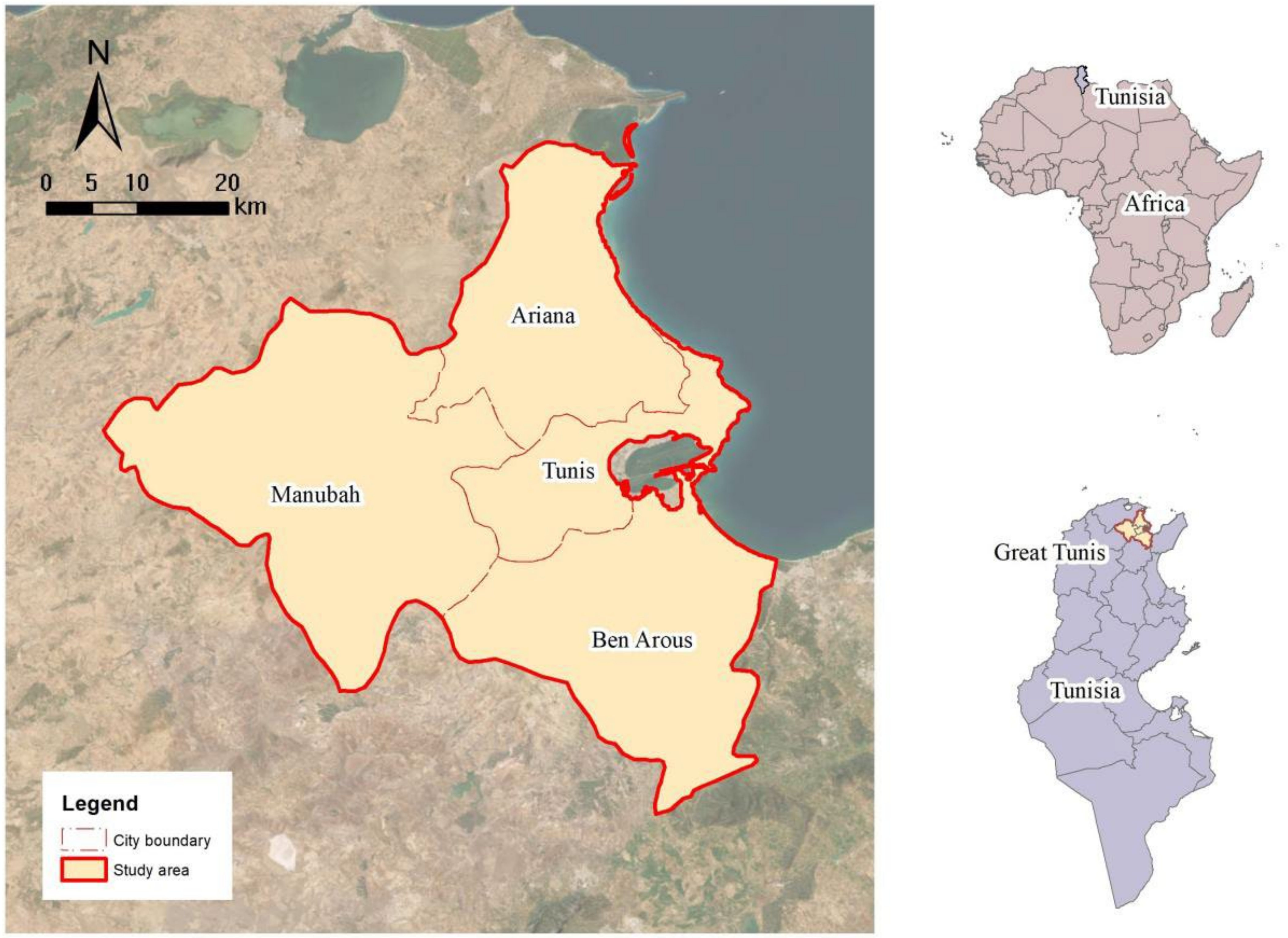
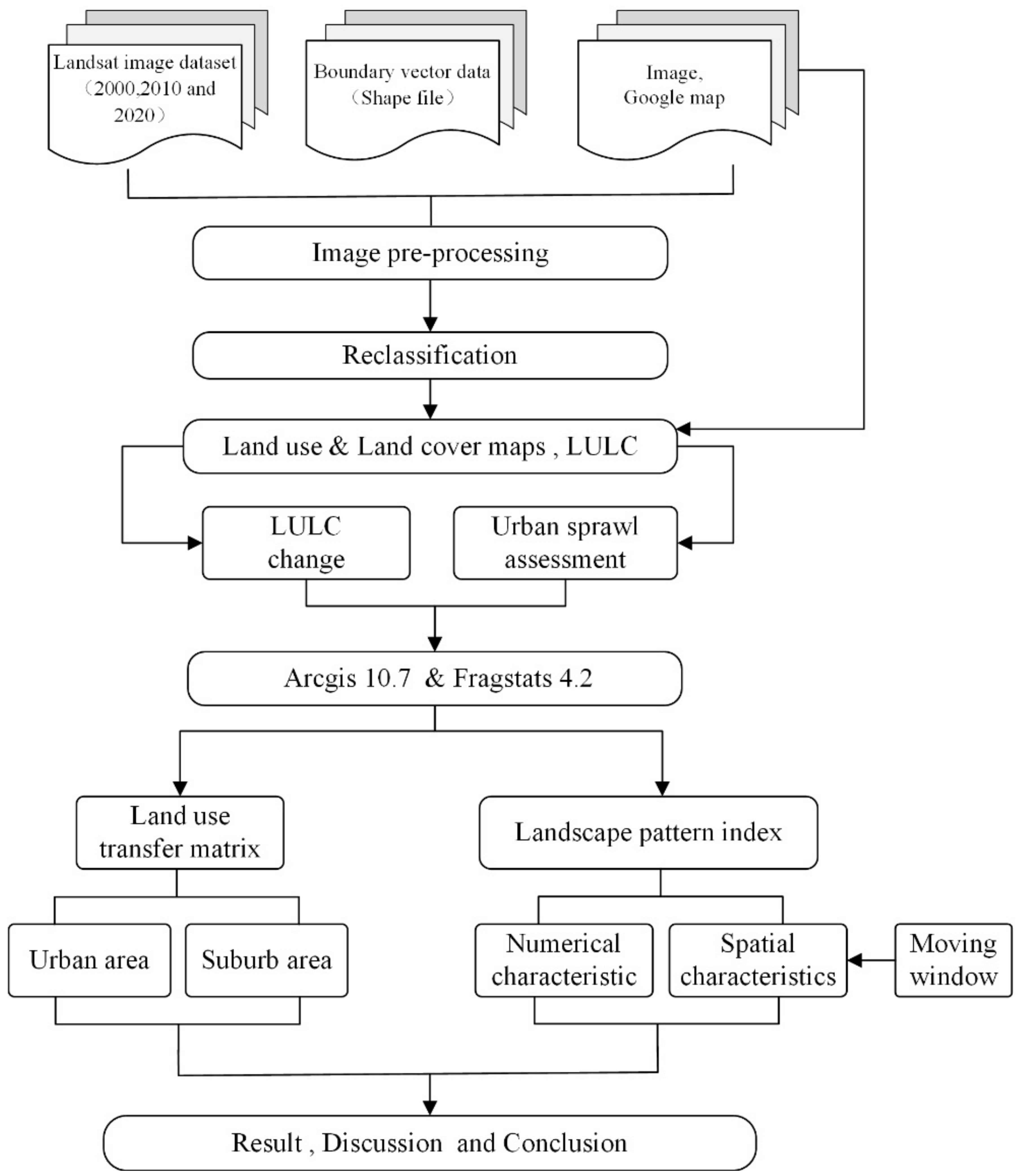



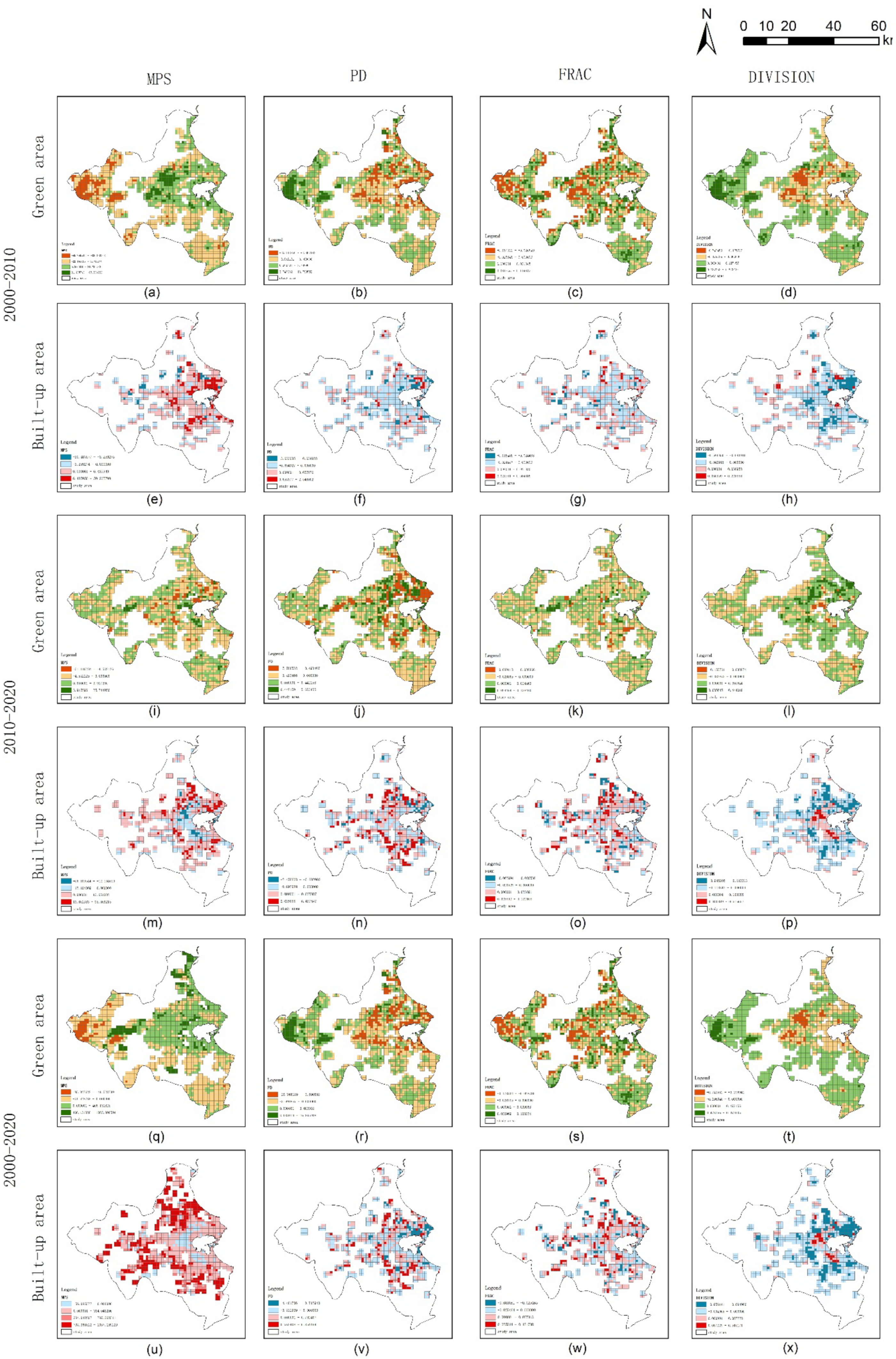
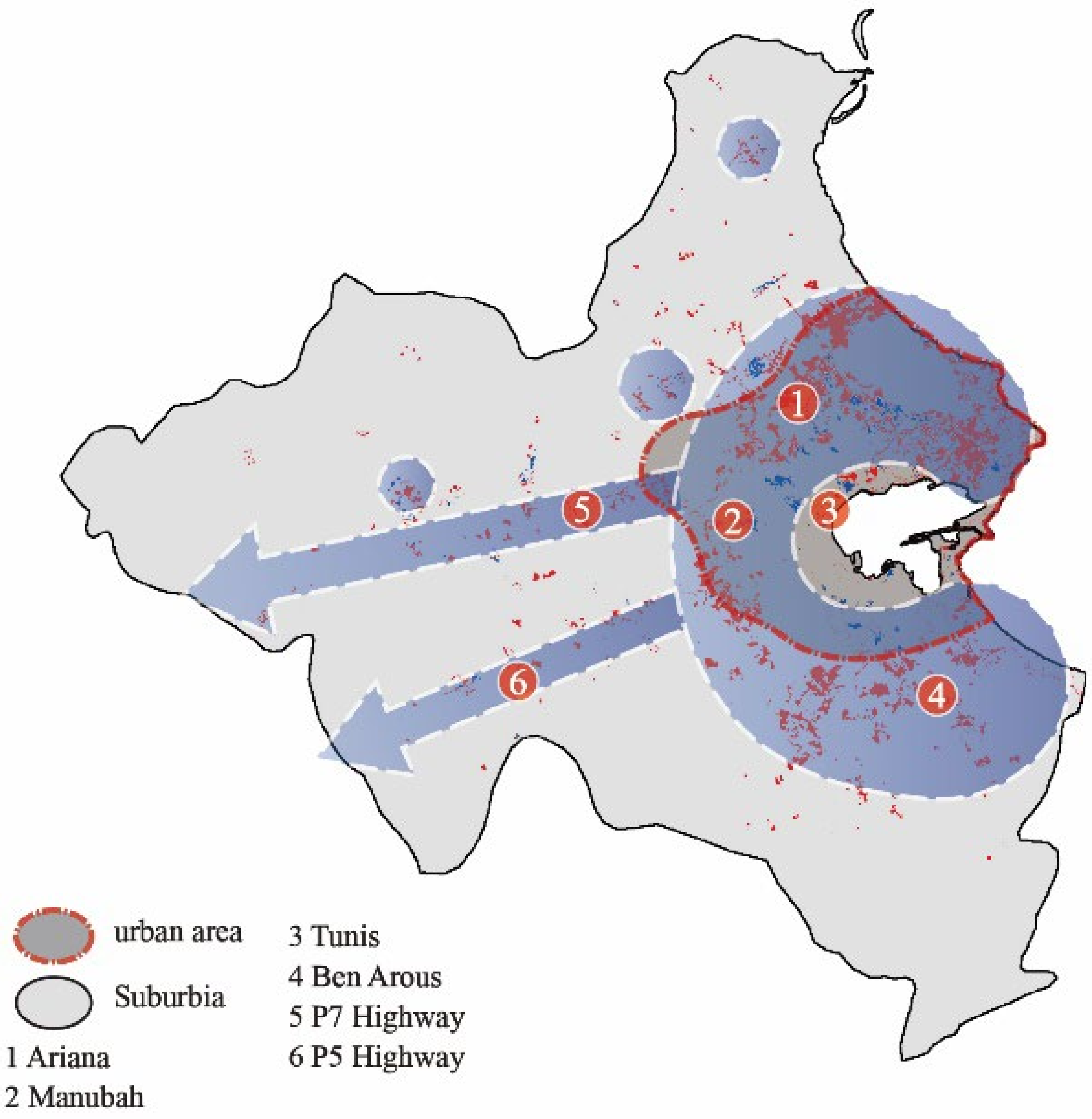
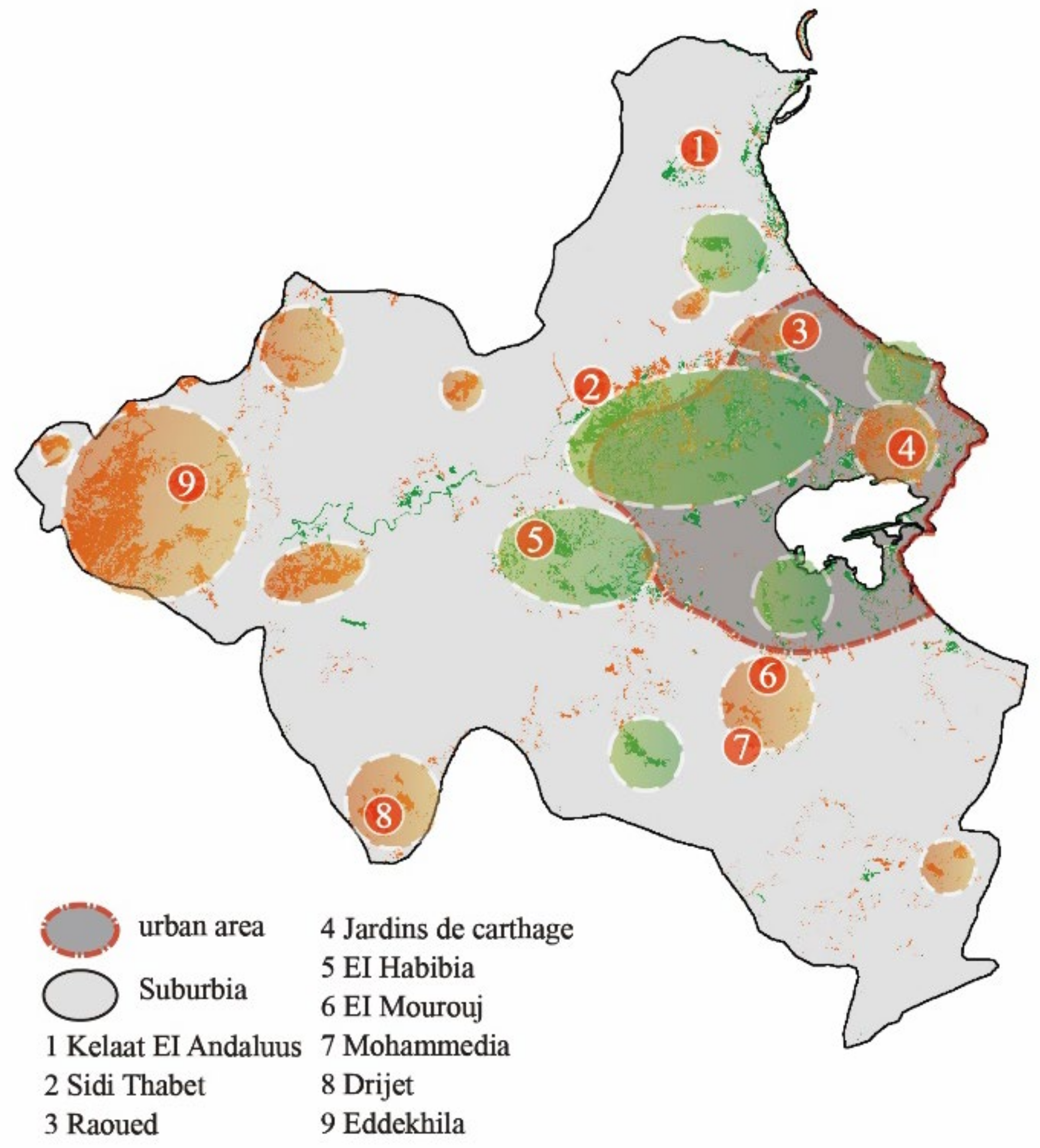

| Landscape Pattern Index | Ecological Implications | Calculation Formula | Parameter Description |
|---|---|---|---|
| CA | Total area of landscape patches | CA = | = total area of the patches |
| NP | Number of landscape patches | NP = | = number of the patches |
| MPS | Average area of individual patches in the landscape | MPS = | = total area of the patches; = number of the patches |
| PD | Number of patches per unit area (density of patches) | PD = ×100 | = total area of the patches; = number of the patches |
| DIVISION | Indicator describing the degree of separation of landscape structures | DIVISION = | = area of the patch; A = total landscape area |
| FRAC_MN | Measure of the complexity of the edge shape of a landscape | FRAC = | = perimeter of the patch; = area of the patch |
| Landscape Pattern Index | Ecological Implications | Calculation Formula | Parameter Description |
|---|---|---|---|
| COHESION | Degree of spatial cohesion between patches | COHESION = (100) | = perimeter of the patch; aij = area of patch j; Z = total number of pixels in the landscape |
| AI | Concentration of patches in a landscape. The higher the value of the clustering index, the more clustered the patches in the landscape | AI = | = number of like neighbors (connections) between pixels of the patch according to the single count method; max-gij = maximum number of like neighbors (connections) between pixels of patches based on the single count method |
| SHDI | Reflects the richness of the landscape | Pi = proportion of patch types in the landscape; n = number of patch types in the landscape | |
| CONTAG | Reflects the degree of landscape agglomeration or extension trend | Pi = proportion of type patches in the landscape; gik = number of neighbors between patch types i and k based on the double counting method; m = number of patch types in the landscape |
| Land-Use Type | 2000 (km2) | 2010 (km2) | 2020 (km2) | Change (km2) | ||
|---|---|---|---|---|---|---|
| 2000–2010 | 2010–2020 | 2000–2020 | ||||
| Cropland | 1544.07 | 1550.95 | 1505.92 | 6.88 | −45.03 | −38.15 |
| Forest | 135.43 | 116.08 | 116.55 | −19.35 | 0.47 | −18.88 |
| Grass | 52.63 | 119.59 | 110.55 | 66.96 | −9.04 | 57.92 |
| Shrub | 391.43 | 300.92 | 298.91 | −90.51 | −2.01 | −92.52 |
| Wetland | 8.86 | 23.96 | 6.11 | 15.1 | −17.85 | −2.75 |
| Water | 37.71 | 26.78 | 54.38 | −10.93 | 27.6 | 16.67 |
| Artificial | 222.58 | 245.44 | 305.08 | 22.86 | 59.64 | 82.50 |
| Bare land | 121.82 | 130.67 | 117.29 | 8.85 | −13.38 | −4.53 |
| Sea | 1.50 | 1.69 | 1.20 | 0.19 | −0.49 | −0.3 |
| 2000–2010 | Cropland | Forest | Grass | Shrub | Wetland | Water | Artificial | Bare Land | Sea | Sum |
|---|---|---|---|---|---|---|---|---|---|---|
| Cropland | 1500.67 | 1.87 | 6.71 | 20.09 | 0.13 | 2.20 | 8.17 | 2.75 | 0.01 | 1542.61 |
| Forest | 2.77 | 79.59 | 4.74 | 45.18 | 0.22 | 0.38 | 1.65 | 1.39 | 0.06 | 135.98 |
| Grass | 3.58 | 2.18 | 19.93 | 21.02 | 0.01 | 0.50 | 1.24 | 5.00 | 0.31 | 53.78 |
| Shrub | 28.76 | 24.28 | 65.51 | 181.27 | 0.31 | 0.68 | 14.89 | 73.28 | 0.02 | 389.01 |
| Wetland | 0.00 | 0.10 | 0.19 | 0.01 | 3.15 | 4.90 | 0.10 | 0.42 | 0.00 | 8.87 |
| Water | 0.84 | 0.72 | 0.25 | 0.30 | 19.14 | 15.88 | 0.42 | 0.17 | 0.00 | 37.72 |
| Artificial | 5.85 | 0.47 | 2.96 | 2.75 | 0.02 | 0.21 | 207.86 | 1.80 | 0.06 | 221.98 |
| Bare land | 7.22 | 6.85 | 19.51 | 29.57 | 0.95 | 1.93 | 10.20 | 46.27 | 0.50 | 123.00 |
| Sea | 0.01 | 0.22 | 0.01 | 0.01 | 0.00 | 0.03 | 0.26 | 0.23 | 0.66 | 1.42 |
| Sum | 1549.71 | 116.29 | 119.81 | 300.19 | 23.95 | 26.72 | 244.79 | 131.30 | 1.62 | 2514.37 |
| 2010–2020 | Cropland | Forest | Grass | Shrub | Wetland | Water | Artificial | Bare Land | Sea | Sum |
|---|---|---|---|---|---|---|---|---|---|---|
| Cropland | 1483.17 | 2.72 | 2.40 | 6.30 | 0.01 | 4.89 | 40.37 | 10.15 | 0.01 | 1550.01 |
| Forest | 0.75 | 96.35 | 0.76 | 16.05 | 0.00 | 0.99 | 0.97 | 0.38 | 0.02 | 116.27 |
| Grass | 2.41 | 0.92 | 81.73 | 19.85 | 0.04 | 0.72 | 11.19 | 2.99 | 0.00 | 119.84 |
| Shrub | 6.19 | 15.65 | 20.10 | 238.77 | 0.01 | 0.33 | 9.62 | 9.59 | 0.00 | 300.25 |
| Wetland | 0.10 | 0.00 | 0.05 | 0.02 | 5.79 | 17.70 | 0.26 | 0.03 | 0.00 | 23.95 |
| Water | 1.51 | 0.29 | 0.30 | 0.53 | 0.00 | 23.70 | 0.14 | 0.24 | 0.00 | 26.71 |
| Artificial | 4.52 | 0.45 | 2.36 | 6.73 | 0.13 | 0.26 | 229.89 | 0.33 | 0.07 | 244.75 |
| Bare land | 6.03 | 0.41 | 3.35 | 10.12 | 0.15 | 5.69 | 11.85 | 93.49 | 0.17 | 131.28 |
| Sea | 0.00 | 0.05 | 0.02 | 0.01 | 0.00 | 0.04 | 0.06 | 0.53 | 0.86 | 1.57 |
| Sum | 1504.68 | 116.84 | 111.06 | 298.38 | 6.12 | 54.32 | 304.34 | 117.73 | 1.14 | 2514.61 |
| 2000–2020 | Cropland | Forest | Grass | Shrub | Wetland | Water | Artificial | Bare Land | Sea | Sum |
|---|---|---|---|---|---|---|---|---|---|---|
| Cropland | 1465.90 | 2.95 | 4.17 | 15.94 | 0.02 | 5.27 | 41.30 | 7.56 | 0.02 | 1543.12 |
| Forest | 1.89 | 84.86 | 3.41 | 42.40 | 0.21 | 0.32 | 1.92 | 0.98 | 0.02 | 136.01 |
| Grass | 2.21 | 1.97 | 21.91 | 19.58 | 0.01 | 0.42 | 2.21 | 5.36 | 0.12 | 53.79 |
| Shrub | 24.46 | 19.98 | 62.62 | 186.86 | 0.36 | 0.79 | 27.69 | 66.36 | 0.02 | 389.13 |
| Wetland | 0.00 | 0.02 | 0.03 | 0.00 | 2.89 | 5.66 | 0.26 | 0.01 | 0.00 | 8.87 |
| Water | 0.72 | 0.48 | 0.22 | 0.19 | 1.62 | 33.85 | 0.35 | 0.28 | 0.00 | 37.71 |
| Artificial | 3.55 | 0.05 | 1.52 | 5.54 | 0.00 | 0.14 | 210.78 | 0.39 | 0.00 | 221.98 |
| Bare land | 6.17 | 6.46 | 17.19 | 27.91 | 1.01 | 7.72 | 19.76 | 36.66 | 0.32 | 123.18 |
| Sea | 0.00 | 0.14 | 0.02 | 0.00 | 0.00 | 0.16 | 0.16 | 0.23 | 0.68 | 1.40 |
| Sum | 1504.90 | 116.91 | 111.08 | 298.43 | 6.12 | 54.33 | 304.42 | 117.83 | 1.17 | 2515.19 |
| Year | CA | NP | PD | MPS | FRAC_MN | DIVISION |
|---|---|---|---|---|---|---|
| 2000 | 57,914.73 | 2441 | 4.21 | 23.73 | 1.0596 | 0.8654 |
| 2010 | 53,711.82 | 2219 | 4.13 | 24.21 | 1.0595 | 0.8709 |
| 2020 | 52,671.78 | 2184 | 4.15 | 24.12 | 1.0600 | 0.8620 |
| Year | CA | NP | PD | MPS | FRAC_MN | DIVISION |
|---|---|---|---|---|---|---|
| 2000 | 22,210.74 | 197 | 0.8870 | 112.74 | 1.1041 | 0.5537 |
| 2010 | 24,494.94 | 158 | 0.6450 | 155.0313 | 1.1046 | 0.5045 |
| 2020 | 30,447.18 | 289 | 0.9492 | 105.35 | 1.0869 | 0.5112 |
| Year | CONTAG | SHDI | AI | COHESION |
|---|---|---|---|---|
| 2000 | 69.7758 | 1.2584 | 96.8942 | 99.5950 |
| 2010 | 69.4899 | 1.2763 | 97.1742 | 99.6608 |
| 2020 | 69.2037 | 1.2864 | 97.1659 | 99.6586 |
Disclaimer/Publisher’s Note: The statements, opinions and data contained in all publications are solely those of the individual author(s) and contributor(s) and not of MDPI and/or the editor(s). MDPI and/or the editor(s) disclaim responsibility for any injury to people or property resulting from any ideas, methods, instructions or products referred to in the content. |
© 2024 by the authors. Licensee MDPI, Basel, Switzerland. This article is an open access article distributed under the terms and conditions of the Creative Commons Attribution (CC BY) license (https://creativecommons.org/licenses/by/4.0/).
Share and Cite
Ben Messaoud, K.; Wang, Y.; Jiang, P.; Ma, Z.; Hou, K.; Dai, F. Spatial-Temporal Dynamics of Urban Green Spaces in Response to Rapid Urbanization and Urban Expansion in Tunis between 2000 and 2020. Land 2024, 13, 98. https://doi.org/10.3390/land13010098
Ben Messaoud K, Wang Y, Jiang P, Ma Z, Hou K, Dai F. Spatial-Temporal Dynamics of Urban Green Spaces in Response to Rapid Urbanization and Urban Expansion in Tunis between 2000 and 2020. Land. 2024; 13(1):98. https://doi.org/10.3390/land13010098
Chicago/Turabian StyleBen Messaoud, Khouloud, Yunda Wang, Peiyi Jiang, Zidi Ma, Kaiqi Hou, and Fei Dai. 2024. "Spatial-Temporal Dynamics of Urban Green Spaces in Response to Rapid Urbanization and Urban Expansion in Tunis between 2000 and 2020" Land 13, no. 1: 98. https://doi.org/10.3390/land13010098
APA StyleBen Messaoud, K., Wang, Y., Jiang, P., Ma, Z., Hou, K., & Dai, F. (2024). Spatial-Temporal Dynamics of Urban Green Spaces in Response to Rapid Urbanization and Urban Expansion in Tunis between 2000 and 2020. Land, 13(1), 98. https://doi.org/10.3390/land13010098







